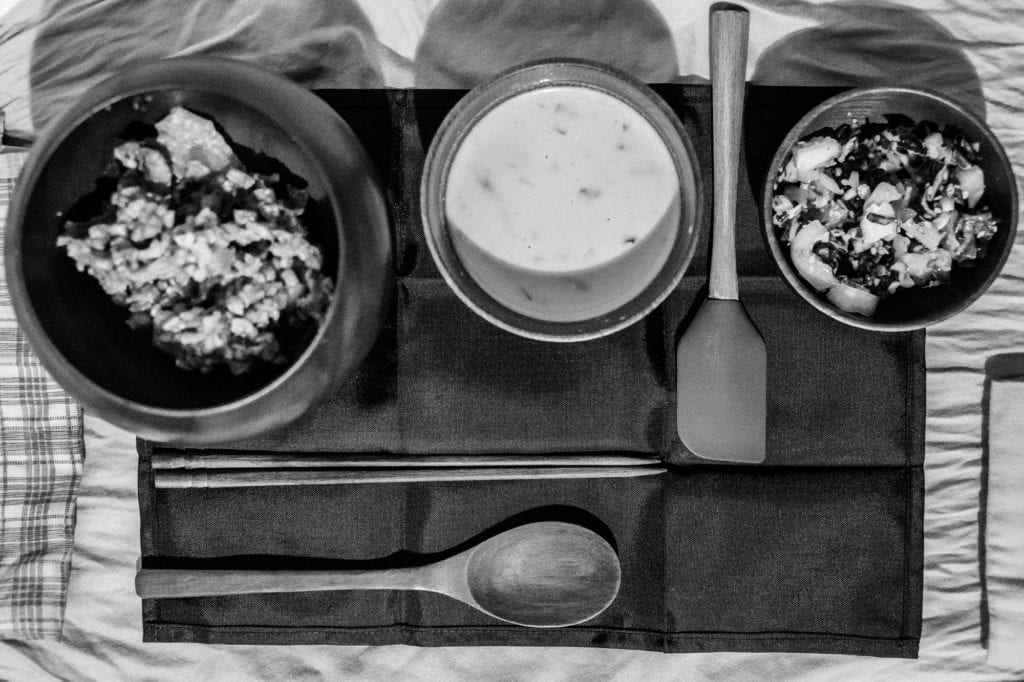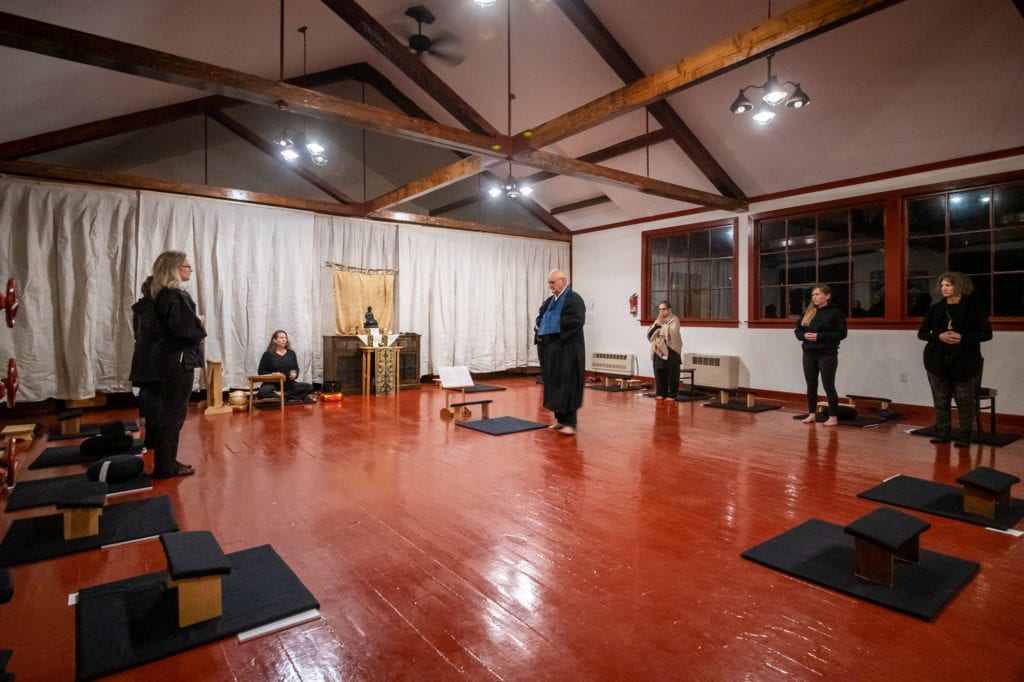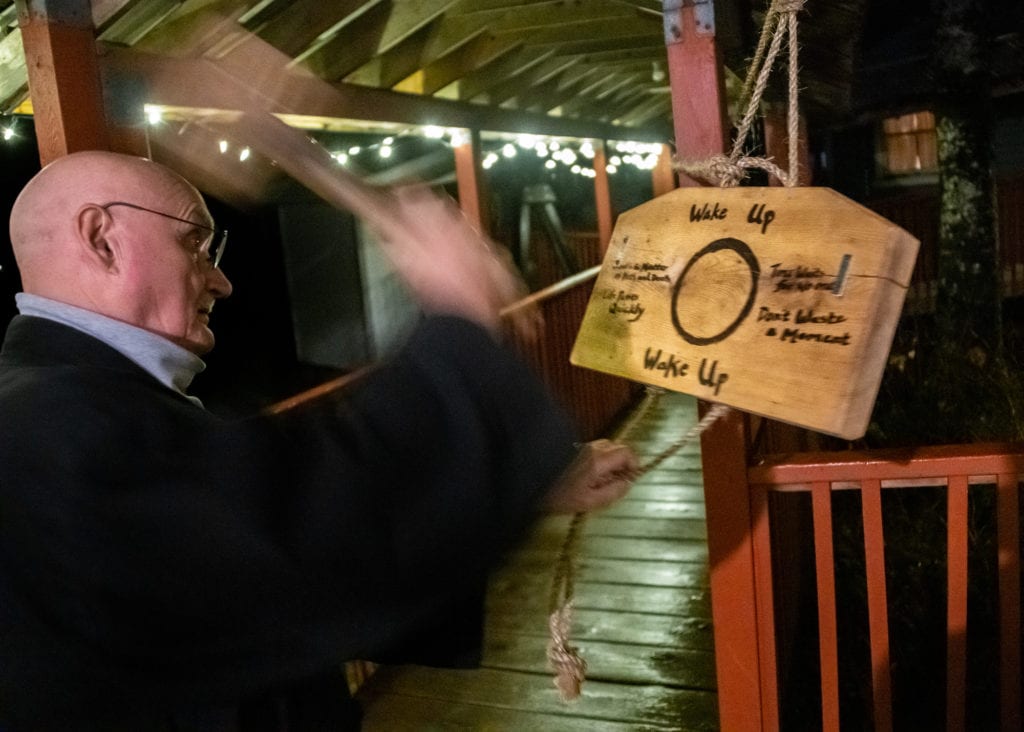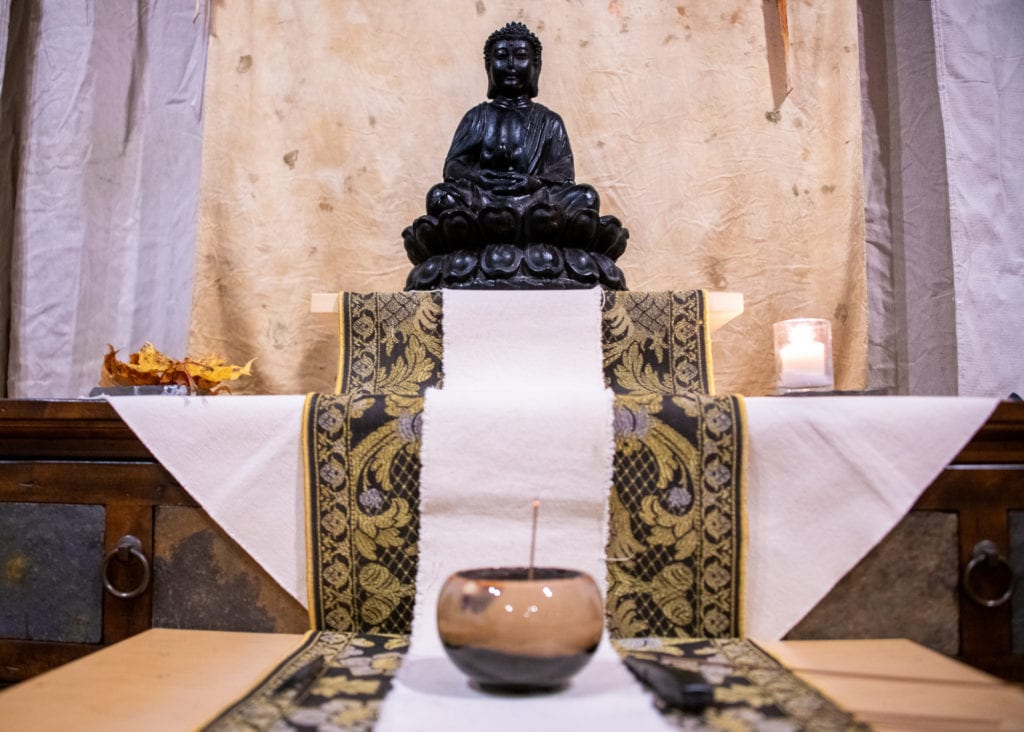
An ōryōki meal should be simple. It consists of foods like rice, soup or fruit, eaten from three bowls. Yet, somehow, sitting down to a formal dining table covered in an array of different-sized forks and spoons isn’t half as challenging as eating a bowl of rice ōryōki-style.
In ōryōki, there is a correct and incorrect way of doing everything, from picking up your napkin to putting down your chopsticks. Once the spoon, chopsticks and three bowls are unpacked, serving takes place in silence, with requests for more or less food expressed through gesture. After eating, the three bowls are cleaned using a small spatula, which is eaten from like a spoon. In the final step of cleaning, hot water is poured from one bowl to the next and then, optionally, drunk. The bowls and utensils can’t be stowed away inside their carrying cloth until they’re as dry and tidy as when they were taken out. At any point, even a minor lapse can create an embarrassing hiccup in the process.
At first blush, it may seem that the purpose of ōryōki is to make eating more trouble than going hungry. But the practice, originally developed by Japanese Buddhists, also compels the eater to focus carefully on what they are doing. To avoid awkward faux pas, one learns not to daydream even for a moment.
“Ōryōki is like everything we do during a retreat,” said Kelly Weaverling, leader of Cordova’s Pathless Way Zen Community. “It may seem a little fussy or persnickety, but, with all these multiple steps, you have to pay attention to everything that you’re doing. Instead of just grabbing some food and gobbling it down, you have to focus on everything in a certain way. Your laundry list, or what you should’ve said to that guy back in junior high — that stuff’s not in your mind, because you’re thinking about what hand the chopsticks go in and how you should fold your napkins and which bowl do you hold, and all that.
“It’s not so much about eating the food as it is about taking a great deal of care with whatever it is that you do. Whether it’s eating the food or preparing the food or washing the dishes, you should be paying attention to that.”

Weaverling is perhaps best known for his term in the ’90s as the nation’s first Green Party mayor. Since then, Weaverling has discarded his mayoral sash for the somber robes of a Zen lay priest. Punctilious yet mischievous, Weaverling exemplifies the sometimes-ironic outlook that sets Zen apart from other schools of Buddhism And, while traditional Zen monasteries address lapses in concentration with a blow across the shoulders with a stick, Weaverling rarely employs more than a pointedly raised eyebrow.
From Oct. 27-Nov. 3, Weaverling led Pathless Way’s third annual Maha Sangha Zen Retreat. The retreat drew 18 attendees, a slight decline from 2018 that Weaverling attributes to the abrupt stoppage of ferry service to Cordova that took effect in September.
The words “Zen retreat” may call to mind nothing so much as tinkling chimes and hot-stone massages. The reality, however, is somewhat different: at 5:15 a.m., Weaverling runs through the bungalow where attendees sleep, ringing a bell loudly. By 5:30, everyone is gathered decorously in Orca Adventure Lodge’s cavernous post-and-beam hall. By daybreak, retreatants have already spent several hours practicing yoga, intoning chants and “sitting zazen,” a Zen method of meditation.
In a Nov. 1 ceremony, six retreatants were recognized as committed Buddhists, donning hangesas they’d stitched and knotted themselves. A hangesa is a garment worn over the shoulders like a pastor’s stole. The hangesa signifies that its wearer, though perhaps not ordained or affiliated with a particular order, is committed to Buddhist practice, Weaverling said.
While different schools of Buddhism vary as widely as different denominations of Christianity, all acknowledge the three fundamental Buddhist tenets: that all things are imperfect, that all things are impermanent and that all things are interconnected. The attendees recognized in the ceremony had demonstrated their understanding of these concepts, Weaverling said.
“You have to acknowledge that, if you’re going to consider yourself a Buddhist of any sort, no matter what the tradition is,” Weaverling said. “If you want to believe that some things are perfect and some things are permanent and some things are not connected to anything else, that’s OK, but it’s not part of a Buddhist tradition.”

Manual labor is part of Zen practice as much as reciting sutras or sitting zazen. Orca Adventure Lodge has permitted Pathless Way to use their restaurant and bungalows in exchange for work like clearing brush. But, with a Zen outlook, doing yard work can be quite as meditative as sitting cross-legged in a cloud of incense. At the Maha Sangha Zen Retreat, attendees took turns cooking, cleaning, serving food and keeping time — practical work that became part of Zen rather than a distraction from it. Ōryōki, too, originated as a practical way of doing things. How better to handle cleaning and sorting dishes among hundreds of monks or nuns than to have everyone do it themselves, according to a standard method?
Retreatant Brianna Beswick was introduced to ōryōki in 2018 when she traveled to Cordova for the Maha Sangha Zen Retreat. Despite its tricky and often vexing nature, ōryōki has helped her grow more aware of those around her, she said. Beswick currently rates her ōryōki skills around a three out of 10.
“It’s not what you would anticipate eating at a meditation retreat is like,” Beswick said. “It’s a different kind of mindful eating.”
Beswick, who has attended retreats from Bozeman, Mont., to Boston, hopes to return for next year’s Maha Sangha Zen Retreat. Even residents who may be indifferent to Buddhism should stop by one of Pathless Way’s weekly meditation sessions, she said. Pathless Way meets Sunday mornings at Cordova’s Current Rhythms dance studio.
While Weaverling served as the sole instructor at this year’s retreat, the 2020 Maha Sangha Zen Retreat is planned also to include Koun Franz, leader of Zen Nova Scotia, and Genmyo Zeedyk, resident priest of the Anchorage Zen Community.
“It’s my hope that everyone has gained a little bit more understanding of this particular Zen path and how it applies to them in their everyday life,” Weaverling said. “It’s one thing to behave in a certain way in a controlled situation, but the proof of the pudding is to take what you’ve learned and apply it in your everyday life. It should be a very practical sort of thing… That’s what Zen’s all about.”

The Three Jewels
Buddhists take refuge in the “Three Jewels”: the Buddha, the Dharma and the Sangha.
- The Buddha: This refers not just to the fifth century B.C. historical figure, but to the Buddha as the exemplification of human awareness. “Buddha” means “awakened one” in Sanskrit.
- The Dharma: This can refer both to the teachings of the Buddha and to the nature of reality itself. Taking refuge in the Dharma can refer to striving to perceive reality more clearly.
- The Sangha: This can refer both to the community of Buddhist monks and nuns and to the larger community of all beings.
Ōryōki meal chant (excerpt)
We reflect on the effort that brought us this food and consider how it comes to us.
We reflect on our virtue and practice, and whether we are worthy of this offering.
We regard it as essential to keep the mind free from excesses such as greed.
We regard this food as good medicine to sustain our life.
For the sake of enlightenment we now receive this food.
First this is for the Three Treasures. (Put spoon in large bowl)
Next for the Four Benefactors. (Put chopsticks across middle bowl)
Finally for the beings in the Six Realms. (Take large bowl)
May all be equally nourished. (Hold up large bowl)
The first portion is to end all evil.
The second is to cultivate all good.
The third is to free all beings.
May we all realize the Buddha way.
Read previous Cordova Times Coverage:
July 5, 2019: Zen group takes the mystery out of meditation





